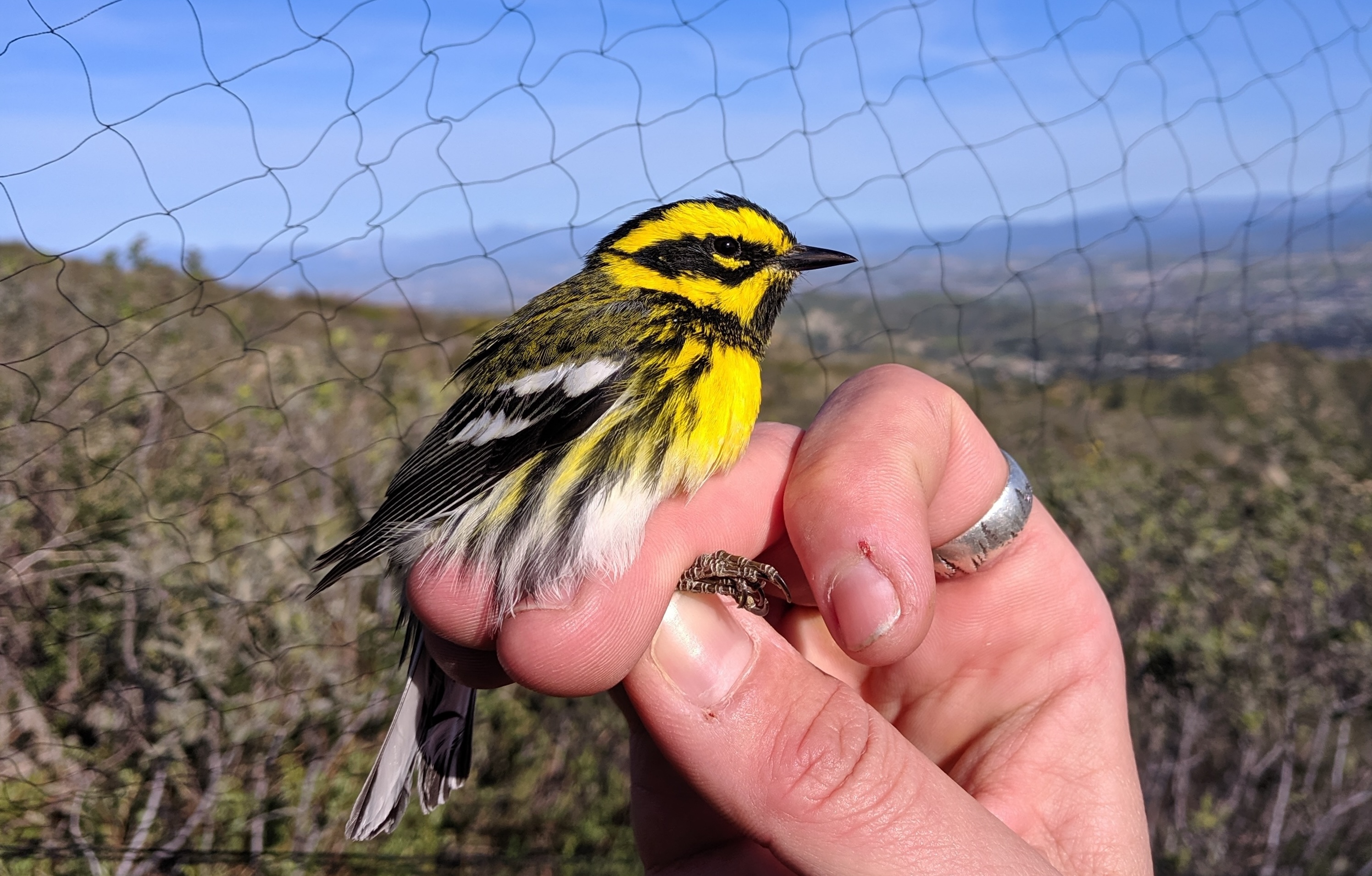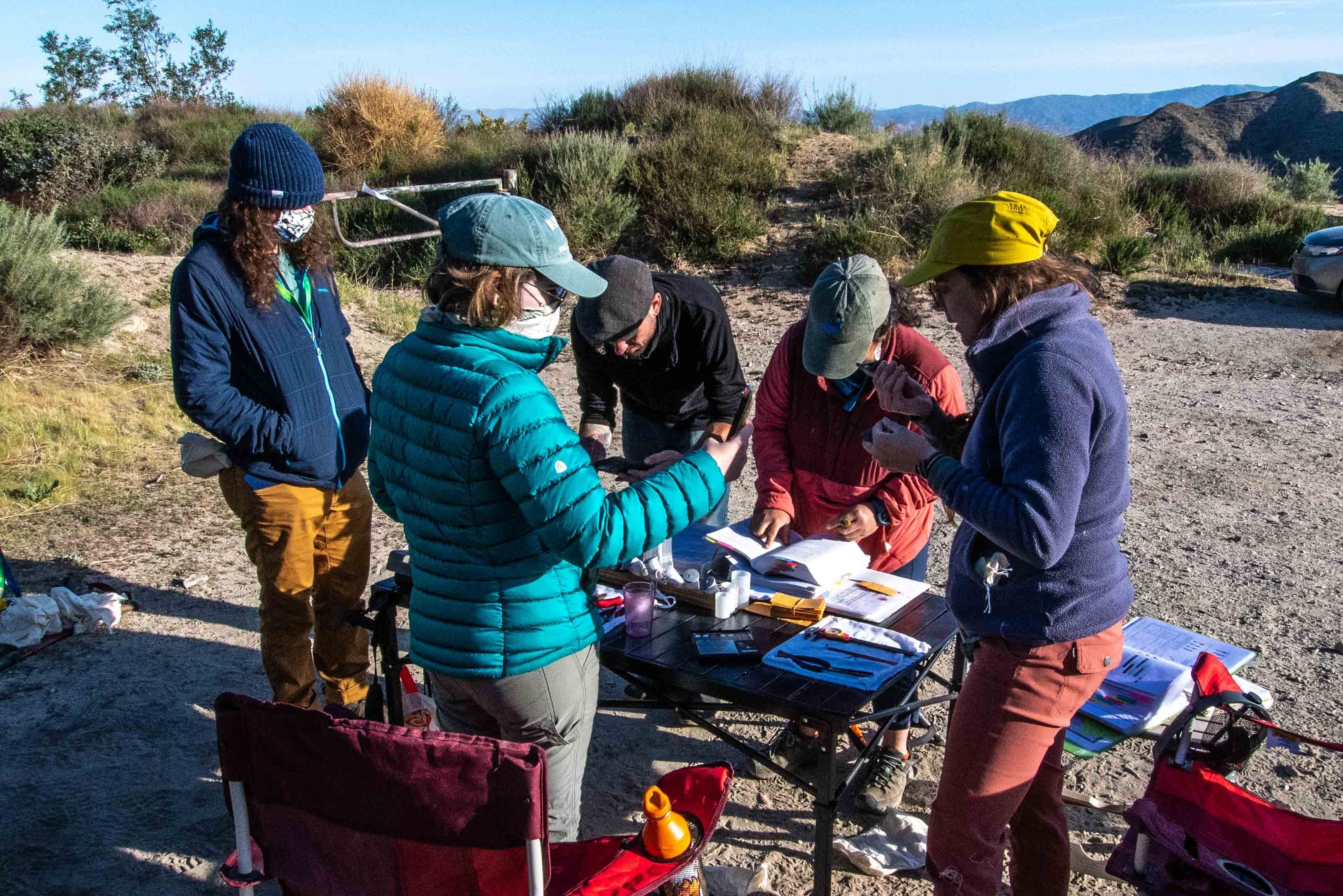Location and Parking
To get to the station, navigate to the Bear Divide Vista Picnic Site. From Sand Canyon Road/Little Tujunga Canyon Road, turn onto the Santa Clara Truck Trail/Forest Service Road 3N17. Pass the paved picnic area on your right and continue down the Santa Clara Truck Trail/Forest Service Road 3N17 until you reach a white gate. If the gate is closed, park on the side of the road (it opens to the public at 6am) and travel in. Note that this road is actively used by fire fighters and that your vehicles should be parked off the main road. If/once the gate is open, continue through a short distance until you reach the dirt pull-out on the right (the fire station will be down below to your left). Pull into the lot and park. Once there, you can’t miss the banding station!

When to Visit
- Banding operations occur from late March until mid-May
- We band 6 days a week, Tuesday-Sunday (Mondays off) from sunrise until around 10am, weather permitting
- Peak migration movement is typically between late April to early May
- We will not operate mist nets in inclement weather including dense fog, high winds, precipitation, and extreme temperatures
- Please note that weather is highly variable at Bear Divide and conditions can change quickly. Banding cancellations are possible when weather conditions are not optimal. The Camp 9 weather station is somewhat reliable for predicting weather conditions in the area.

Best Time to Observe the Migration
- Bird movement is best observed between 6:30 am and 9:00 am
- Peak migration is between late April to early May
- In general, observation of bird movement is variable and dependent on local weather conditions
- Conditions for observable morning flight often include high visibility (no fog, low humidity, no precipitation), north winds (headwinds appear to push birds lower toward the ground), moderately warm temperatures following sunrise (partly to mostly sunny)
- If inclement weather is present at the site, migrants will typically fly at higher elevations (making detection difficult), or they will concentrate in vegetated areas lower in the canyon. On these days, we encourage visitors to bird Sand Canyon, East Walker Ranch, and Placerita Canyon for migrants
- The banding season occurs between late March to mid-May, however the Migration Count (point count) team’s season runs from mid-March to early June
- Though the bulk of the migration movements dwindle by mid-May, the opportunity for migratory vagrants increases
- The site is open to the pubic year-round and visitors may bird the area at any time of year—however, Bear Divide appears to be utilized exclusively as a migratory corridor during the spring

Amenities
- Cell service is spotty and can be unreliable
- There are no bathrooms or running water available onsite. The closest public restroom is located at the Placerita Canyon Nature Center 6.5 miles (10 minute drive) away from the station
- There is minimal shade (though early mornings are regularly cloudy and foggy)
- All trash must be packed-out or disposed of in the trash cans at the Bear Divide Vista Picnic Site
- We encourage carpooling as parking can be limited at times

Accessibility
Parking
- The banding station parking lot is made up of hard-packed dirt with loose gravel and some potholes/bumps. No marked parking stalls of any kind are present.
- The Santa Clara Truck Trail is made up of asphalt and is 17 feet (5.2 meters) wide. A 15 foot (4.6 meter) swing gate opens to the public at 6am. Travel up a gradient of over 5% will be necessary to reach the banding station.
- Bear Divide Vista Picnic Site parking lot is made of asphalt and has no marked accessible parking stalls. Parking here will require travel up the Santa Clara Truck Trail (reference above).
General
- Groups of 10 to 30+ people often gather at the banding station and along the Santa Clara Truck Trail to bird in the spring. Trail users also include bikers and fire station/maintenance trucks.
- No benches, steps, railings, or safety barriers are present in the parking areas detailed above. Safety barriers (cones and parked cars) are present at the banding station.
- There are no fees to visit the banding station, though donations are greatly appreciated.

What to Bring
- Sun protection (hats, sunglasses, sunscreen, long sleeves)
- Clothing layers (weather often fluctuates, hot and cold extremes)
- Closed-toe shoes
- Binoculars and/or camera
- Snacks and water
- Camp chair/stool

Visitor Etiquette
What to expect from us
- We will create opportunities for questions, up-close bird viewing/photography, and releasing of banded birds as bird volume and safety permits
- Though we’ll do our absolute best to show birds, bird safety is our highest priority
What we expect from you
- Please stay behind the orange cones surrounding the station at all times
- Reserve questions and photography until approached by a bander
- Keep voices down while we process birds and collect data
- Refrain from approaching the mist nets
- Adhere to our photography etiquette standards (reference below)

Photography Etiquette
Photography is generally allowed if it does not interfere with normal banding processes and as banding volume permits. We will provide as many up-close photo opportunities as possible while birds are safely held in the appropriate holds as time and safety allows. To minimize handling time, please be ready for photos when approached by a bander. The Bear Divide Banding Station follows the North American Banding Council’s Photographic Guidelines. Below is a summary.
- Do not photograph or post publicly on social media or otherwise photos that depict birds in inappropriate holds or appear to be showing signs of stress including, but not limited to, closed eyes, gaping or open bills, fluffed or rumpled plumage, or flapping wings as it is important to us to avoid any instances of misrepresentation or misinterpretation of banding efforts. If you are unsure if your photo is appropriate to share, please check with the Bander-in-Charge.
- Refrain from taking images of birds in mist nets, during net extraction, or during processing, unless permission is obtained from the Bander-in-Charge
- Only take photographs or videos when approached by a trained bander with birds in the appropriate photographer’s grip intended for public display and engagement
- Avoid ALL flash photography
- We reserve the right to ask for the removal or deletion of inappropriate photos that do not meet our station’s or the NABC’s photographic standards.

Schedule a Visit
Visiting with a group larger than 10 people? Give us a heads up with the form below! For visiting school groups and organizations, please consider a donation of $5-$10 per person in attendance as this is our main funding source for our research. Groups unable to donate are still welcome to visit and participate.

